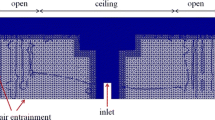Abstract
The main objective of the present work is an investigation of the accuracy and the reliability of numerical predictions of ceiling jets induced by fire plumes, aiming at practical applications to fire-safety planning. Ceiling jet phenomena are studied numerically using the standard k-ɛ model of turbulence. Computed results are compared with basic experimental data. Of particular interest is the dependence of (a) the computational mesh system, (b) the incompressible or compressible flow assumptions, and (c) initial values of k and ɛ at the inflow on the ceiling jet solutions.
Similar content being viewed by others
References
D.D. Evans, “Ceiling Jet Flows,” in SFPE Handbook of Fire Protection Engineering, National Fire Protection Association, Quincy, MA, 1988, pp. 1-138–145.
S. Yokoi, “Study on the Prevention of Fire-Spread Caused by Hot Upward Current,” Report of the Building Research Institute, no.34, 1960.
T. Hara and S. Kato, “Numerical Simulation of Thermal Plumes in Free Space Using the Standard k-ɛ Model,” Fire Safety Journal (submitted), also in Journal of Archit. Plann. Environ. Eng., AIJ, no. 530, April 2000, pp. 39–46 (in Japanese).
T. Hara, M. Yokoi, and S. Kato, “Numerical Study of Thermal Plume in Corner Walls with Smoke Movement in Fire by Means of the Standard k-ɛ Model,” in Proceedings of the Fourth Asia-Oceania Symposium on Fire Science and Technology, AOAFST and JAFSE, May 2000, pp. 413–424.
G. Heskestad and T. Hamada, “Ceiling Jets of Strong Fire Plumes,” Fire Safety Journal, vol. 21, 1993, pp. 69–82.
R.L. Alpert, “Calculation of Response Time of Ceiling-Mounted Fire Detectors,” Fire Technology, vol. 8, 1972, pp. 181–195.
L.Y. Cooper, “Fire-Plume-Generated Ceiling Jet Characteristics and Convective Heat Transfer to Ceiling and Wall Surfaces in a Two-Layer Fire Environment: Uniform Temperature Ceiling and Walls,” Fire Science and Technology, vol. 13, no. 1 and 2, 1993, pp. 1–17.
E.E. Zukoski, “Fluid Dynamic Aspects of Room Fires,” in Proceedings of the First International Symposium, Fire Safety Science, 1985, pp. 1–30.
S. Nam and R.G. Bill Jr., “Numerical Simulation of Thermal Plumes,” Fire Safety Journal, vol. 21, 1993, pp. 231–256.
V. Motevalli, “Numerical Prediction of Ceiling Jet Temperature Profiles During Ceiling Heating Using Empirical Velocity Profiles and Turbulent Continuity and Energy Equations,” Fire Safety Journal, vol. 22, 1994, pp. 125–144.
H. Tuovinen, “Validation of Ceiling Jet Flows in a Large Corridor with Vents Using the CFD Code JASMINE,” Fire Technology, vol. 32, no. 1, 1996, pp. 25–49.
NFPA, “Technical Guide for Smoke Management Systems in Halls, Atria, and Large Areas,” National Fire Protection Association, NFPA 92B-1991, Quincy, MA, 1991.
K.B. McGrattan, H.R. Baum, R.G. Rehm, A. Hamins, G.P. Forney, J.E. Floyd, and S. Hostikka, “Fire Dynamics Simulator (Version 2)-Technical Reference Guide,” National Institute of Standards and Technology, NISTIR 6783, Gaithersburg, MD, 2001.
T. Matushita, H. Fukutani, and M. Matsumoto, “Mathematical Model and Experiments of Axisymmetric Spread of Smoke Front under Ceiling (Part I), Axisymmetric Spread of Density Flow Front with Constant Density,” Bulletin of Japanese Association of Fire Science and Engineering, vol. 48. no. 1, 1998, pp. 19–24.
T. Matushita, H. Fukutani, and M. Matsumoto, “Mathematical Model and Experiments of Axisymmetric Spread of Smoke Front under Ceiling (Part II), Axisymmetric Spread of Density Flow Front with Changing Temperature,” Bulletin of Japanese Association of Fire Science and Engineering, vol. 48, no. 2, 1998, pp. 1–7.
Computational Dynamics Limited, Computational Fluid Dynamics Software, STAR-CD, Version 3.05, Theory Manual, CD adapco JAPAN, Yokohama, Japan, 1998.
P.L. Viollet, “The Modeling of Turbulent Recirculating Flows for the Purpose of Reactor Thermal-hydraulic Ananlysis,” Nuclear Engineering and Design, vol. 99, 1987, pp. 365–377.
W.M. To and J.A.C. Humphrey, “Numerical Simulation of Buoyant, Turbulent Flow-1. Free Convection along a Heated, Vertical, Flat Plate,” International Journal of Heat Mass Transfer, vol. 29, no. 4, 1986, pp. 573–592.
Z. Yan and G. Holmstedt, “A Two-Equation Turbulence Model and its Application to a Buoyant Diffusion Flame,” International Journal of Heat and Mass Transfer, vol. 42, 1999, pp. 1305–1315.
S. Kato, S. Murakami, and R. Yoshie, “Experimental and Numerical Study on Natural Convection with Strong Density Variation along a Heated Vertical Plate,” in Proceedings of the 9th Symposium on Turbulent Shear Flows, Kyoto, Japan, 1993, pp. 12–15.
S.V. Patankar, Numerical Heat Transfer and Fluid Flow, Hemisphere, Washington, DC, 1980.
S. Murakami, A. Mochida, and Y. Hayashi, “Scrutinizing k-ɛ EVM and ASM by Means of LES and Wind Tunnel for Flowfield around Cube,” in Proceedings of the 8th Symposium on Turbulent Shear Flows, 1991, pp. 17-1-1–17-1-6.
Author information
Authors and Affiliations
Rights and permissions
About this article
Cite this article
Hara, T., Kato, S. Numerical Simulation of Fire Plume-Induced Ceiling Jets Using the Standard kε Model. Fire Technol 42, 131–160 (2006). https://doi.org/10.1007/s10694-006-7504-y
Published:
Issue Date:
DOI: https://doi.org/10.1007/s10694-006-7504-y




